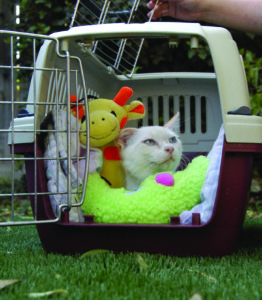I’m always thankful for the opportunity to be able to help pet owners, and in turn help make things easier for pets that have been entrusted into our care.
This month’s topic is one that comes often, and it is frequently asked by clients at the clinic where I work. The question is, “How do I get my cat to go in the carrier easier?”
The first thing I ask them is “where do you keep your carrier?” The most common answers are the garage, basement, and the attic. This means cats are often put into a dusty, cobweb-coated carrier and brought into the clinic. Please note that not everyone does this, but I see it quite frequently, almost as much as a clean carrier with a towel or bed inside it.
The first step to getting your cat used to the carrier is to leave it out all the time. This way the sight of the carrier is not sudden — it’s just part of the furniture in the home. Most carriers fit under end tables or can be put in a corner of the room. Simply doing this can ease the stress of going inside the carrier as it’s not just a scary thing that comes out only when they are hurt, sick, or they are just going in for annual care.
Next, start feeding your kitty inside the carrier. If kitty is too nervous to go inside the carrier to eat, start off with the food near the door of the kennel and slowly move the dish closer. As kitty adjusts you can put it inside where kitty should eat calmly and be relaxed in the carrier.
Make the carrier a fun place by using it to play games with your kitty. Toss a favorite toy in there for fun inside the carrier, or toss treats into the carrier so kitty can chase them and then eat them inside the carrier.
If your kitty has had a bad experience in a certain type of carrier, get another one in a different style. Carriers can be soft-sided, metal, wicker, nylon or cloth. You can even try being inventive with what you use as a carrier for your kitty. I have one client who used to bring their kitty to the clinic in a carrier, and no matter what she tried, the cat would really hate going in there! Then the owners noticed how she loved sleeping in the laundry basket. They now bring her into the clinic inside “her” laundry basket (with the top secured for safe travel). They told me she was purring all through the drive to the clinic, and I can attest she was the best, most calm cat she had ever been for veterinary care.
A pillowcase can also make a great carrier in a pinch. Just take the pillowcase off your pillow (so it has familiar scents on it) and put kitty in for travel. They can breathe just fine through the fabric, and some cats even prefer this to a carrier. The important thing is to take time to learn which form of transport is the least stressful.
Here is a helpful video on how to get your cat into a pillow case: https://www.youtube.com/watch?v=x-GyEGDmpzY
The use of Feliway can help calm your kitty for travel, too. It basically tells your kitty they have marked the carrier as theirs already so they can relax.
If your kitty gets really stressed during travel, there are many supplements and medications that can help ease your kitty’s nerves during travel. Don’t hesitate to discuss your concerns with your veterinarian. Tell them exactly what your cat does during travel. This will help her to find the right tools to make your pet more comfortable.







